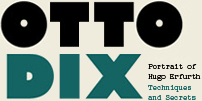

Otto Dix
Hugo Erfurth with Dog, 1926
Tempera and oil on panel. 80 x 100 cm.
Museo Thyssen-Bornemisza, Madrid
Hugo Erfurth with Dog, 1926
Tempera and oil on panel. 80 x 100 cm.
Museo Thyssen-Bornemisza, Madrid
VISIBLE LIGHT
The use of visible light enables conservators to capture surface details without using specialised equipment. Macro photography—the enlargement of images in close-up shots that provide information about the topmost plane of the picture—has revealed peculiarities in the surface of the painting that are not perceptible to the human eye, disclosing a wealth of shadings and brushstrokes, details which would go unnoticed without such amplifications.
The use of visible light enables conservators to capture surface details without using specialised equipment. Macro photography—the enlargement of images in close-up shots that provide information about the topmost plane of the picture—has revealed peculiarities in the surface of the painting that are not perceptible to the human eye, disclosing a wealth of shadings and brushstrokes, details which would go unnoticed without such amplifications.

Otto Dix
Hugo Erfurth with Dog (infrared reflectography), 1926
Tempera and oil on panel. 80 x 100 cm.
Museo Thyssen-Bornemisza, Madrid
Hugo Erfurth with Dog (infrared reflectography), 1926
Tempera and oil on panel. 80 x 100 cm.
Museo Thyssen-Bornemisza, Madrid
INFRARED REFLECTOGRAPHY
This testing technique consists in illuminating a work with incandescent lamps and registering the reflected radiation with a system that is sensitive to the infrared band of the spectrum. Some electromagnetic waves pass through the upper surface while others are absorbed and reflected off the underlying layers, revealing the underdrawing of the painting. IR shows a key stage in the artist’s creative process, but one of which little is generally known as it lies hidden under the overlying paint. Underdrawings point to changes in composition, pentimenti… on occasion they can even facilitate the reading of unclear signatures and inscriptions.
This testing technique consists in illuminating a work with incandescent lamps and registering the reflected radiation with a system that is sensitive to the infrared band of the spectrum. Some electromagnetic waves pass through the upper surface while others are absorbed and reflected off the underlying layers, revealing the underdrawing of the painting. IR shows a key stage in the artist’s creative process, but one of which little is generally known as it lies hidden under the overlying paint. Underdrawings point to changes in composition, pentimenti… on occasion they can even facilitate the reading of unclear signatures and inscriptions.

Otto Dix
Hugo Erfurth with Dog (x-radiography), 1926
Tempera and oil on panel. 80 x 100 cm.
Museo Thyssen-Bornemisza, Madrid
Hugo Erfurth with Dog (x-radiography), 1926
Tempera and oil on panel. 80 x 100 cm.
Museo Thyssen-Bornemisza, Madrid
X-RADIOGRAPHY
This testing technique passes radiation through an object onto a photographic plate to disclose differences in the absorption of materials. By means of the electromagnetic radiation they emit, these rays can penetrate through all of a painting’s layers, including the support, thus providing a superb density map, a single image packed with information about the painting: its condition, material composition, creative process...
This testing technique passes radiation through an object onto a photographic plate to disclose differences in the absorption of materials. By means of the electromagnetic radiation they emit, these rays can penetrate through all of a painting’s layers, including the support, thus providing a superb density map, a single image packed with information about the painting: its condition, material composition, creative process...

Otto Dix
Hugo Erfurth with his Dog Ajax, 1926
Charcoal and pencil with white highlights on paper mounted over cardboard.
84,3 x 100,2 cm.
Staatliche Museen zu Berlin, Kupferstichkabinett, Berlin
Hugo Erfurth with his Dog Ajax, 1926
Charcoal and pencil with white highlights on paper mounted over cardboard.
84,3 x 100,2 cm.
Staatliche Museen zu Berlin, Kupferstichkabinett, Berlin
PREPARATORY SKETCH
The preparatory sketch is a drawing made with the intention of transferring a design onto another surface, generally of large dimensions. One of the preparatory drawings for this painting is “Hugo Erfurth with his Dog Ajax”, on loan from the Berlin Kupferstichkabinett, whose composition is very close to the final painting. The technique used in the cartoon is charcoal and pencil with white highlights on light-brown paper mounted over cardboard, in which the treatment of lights and shadows stands out, especially in the photographer’s face and in certain decorative elements of his clothing, such as the tie, where the lines are more firm and contain a more concise design than in the dog, whose lines are thicker.
The preparatory sketch is a drawing made with the intention of transferring a design onto another surface, generally of large dimensions. One of the preparatory drawings for this painting is “Hugo Erfurth with his Dog Ajax”, on loan from the Berlin Kupferstichkabinett, whose composition is very close to the final painting. The technique used in the cartoon is charcoal and pencil with white highlights on light-brown paper mounted over cardboard, in which the treatment of lights and shadows stands out, especially in the photographer’s face and in certain decorative elements of his clothing, such as the tie, where the lines are more firm and contain a more concise design than in the dog, whose lines are thicker.















